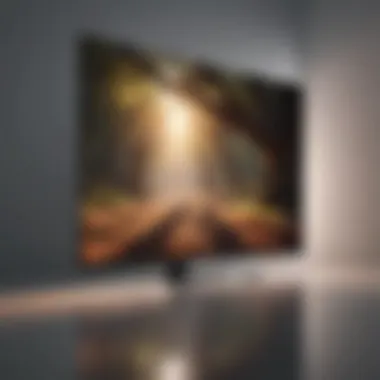Discover the Top TVs for Optimal Side Viewing Experience


In delving into the realm of choosing the best TVs for side viewing, it is crucial to consider key factors that greatly enhance the overall viewing experience from varying angles. From cutting-edge technology to the most suitable screen sizes, this detailed guide navigates the expansive landscape of television displays, aiding you in making a well-informed decision tailored precisely to your unique viewing requirements.
Exploration of Key Factors
One of the primary factors to examine when looking for the ideal TV for side viewing is the panel technology employed in the display. Modern TVs often come with advanced IPS (In-Plane Switching) or VA (Vertical Alignment) panels, both offering distinct advantages. IPS panels are known for their superior viewing angles and color accuracy, making them particularly suitable for side viewing scenarios where multiple viewers may be watching from different positions. On the other hand, VA panels typically provide better contrast ratios and deeper blacks, which can enhance the viewing experience, especially in darker settings. Understanding the nuances of panel technology can significantly impact your choice based on your viewing preferences.
Another vital consideration in selecting a TV for optimal side viewing is the screen size and resolution. While larger screens can offer a more immersive experience, they may not always be practical for side viewing, as they can cause strain on the eyes when watching from acute angles. In contrast, smaller screens may not provide the same level of immersion but are often more suitable for side viewing due to reduced distortion and easier viewing from the side. Additionally, investing in a TV with a higher resolution, such as 4K or even 8K, can further enhance the clarity and sharpness of images, providing a more detailed viewing experience from any angle.
The Importance of Viewing Angles
Viewing angles play a pivotal role in determining the quality of the viewing experience, particularly from the side. Traditional LCD panels have limitations in terms of viewing angles, with colors and contrast deteriorating when viewed off-center. However, newer technologies like OLED (Organic Light-Emitting Diode) displays excel in this aspect, offering exceptional viewing angles with consistent colors and contrast across the screen. Understanding the impact of viewing angles can help you select a TV that ensures an immersive and enjoyable viewing experience for everyone watching, regardless of their position relative to the screen.
Connectivity and Features
Beyond the display technology and screen size, considering the connectivity options and additional features of a TV is essential for optimizing side viewing. TVs with multiple HDMI ports, USB inputs, and wireless capabilities provide greater flexibility in connecting external devices, such as gaming consoles, media players, and streaming devices. Moreover, features like HDR (High Dynamic Range), local dimming, and motion smoothing can further enhance the visual quality and performance of the TV, delivering a superior viewing experience from any angle. By evaluating the connectivity and features of a TV, you can ensure seamless integration with your existing setup and maximize the enjoyment of side viewing.
Conclusion
Introduction
Within the realm of television displays, side viewing plays a critical role in enhancing the viewing experience. The way a TV performs when viewed from different angles can significantly impact the immersion and enjoyment of users. Understanding the nuances of side viewing is essential for individuals who prioritize optimal screen performance. This article serves as a comprehensive guide to unraveling the best TVs for side viewing, shedding light on key factors that influence viewing quality.
Understanding Side Viewing in Television Displays
Importance of Viewing Angles
Viewing angles are crucial elements in the world of television displays as they determine how well a TV maintains picture quality when viewed from different positions relative to the screen. The importance of viewing angles lies in ensuring that the content on the screen remains clear and vibrant, regardless of where the viewer is positioned. Optimal viewing angles contribute to a versatile viewing experience suitable for various seating arrangements in a room. Understanding the significance of viewing angles helps users select TVs that can deliver consistent performance regardless of their location in relation to the screen.
Challenges of Side Viewing
Challenges in side viewing arise when the viewing angles are not adequately supported by the TV technology. Suboptimal viewing angles can result in distortion, color inaccuracies, and reduced image clarity when watching the TV from the side. Overcoming these challenges requires TVs with advanced panel technology and features that can mitigate the negative effects of side viewing. It is essential for consumers to be aware of these challenges to make informed decisions when choosing a TV model that excels in side viewing capabilities.
Key Considerations for Side Viewing
Screen Size
The screen size of a TV directly impacts the viewing experience, particularly when viewing from the side. Larger screens provide a more immersive viewing experience with better visibility from various angles. However, excessively large screens can lead to pixelation and reduced picture quality when viewed from the side. Finding the right balance between screen size and optimal viewing angles is crucial for achieving an enjoyable side viewing experience.


Panel Technology
Panel technology influences how well a TV performs when viewed from different angles. Advanced panel technologies, such as OLED and QLED, offer superior viewing angles with minimal color distortion, making them ideal choices for side viewing. Understanding the nuances of panel technology helps users select TVs that excel in maintaining picture quality even when viewed from extreme angles.
Brightness and Contrast
Brightness and contrast levels play a significant role in side viewing as they determine the clarity and sharpness of the images when viewed off-axis. TVs with high brightness and contrast ratios provide better visibility and image quality when watched from the side. Balancing brightness and contrast is essential to ensure that the content remains vivid and engaging, even during side viewing scenarios.
Impact on Viewing Experience
Enhanced Immersion
Enhanced immersion refers to the ability of a TV to draw viewers into the content, creating a captivating and realistic viewing experience. TVs that excel in side viewing enhance immersion by maintaining consistent picture quality and color accuracy even from extreme angles. Immersive viewing experiences elevate the overall enjoyment of watching movies, TV shows, or gaming sessions, making side viewing a delightful experience for users.
Reduced Distortion
Reducing distortion in side viewing scenarios is crucial for preserving image quality and color accuracy across different viewing angles. TVs that minimize distortion offer clear and sharp images even when watched from challenging positions. By mitigating distortion, viewers can enjoy a seamless viewing experience without worrying about compromising picture quality when sitting off-center from the TV screen.
Optimal TV Models for Side Viewing
In this segment, we delve into the crucial aspect of Optimal TV Models for Side Viewing. Selecting the right TV model greatly enhances the side viewing experience. When considering the optimal TV models, various factors play a pivotal role in ensuring an immersive viewing experience. Screen size, panel technology, brightness, and contrast are key elements to focus on when choosing a TV for side viewing. Screen size impacts the overall viewing experience, with larger screens providing a more engaging visual encounter. Panel technology, such as OLED and QLED, influences the picture quality and viewing angles, contributing significantly to the overall performance. Additionally, brightness and contrast levels determine the clarity and depth of images, making them essential considerations when selecting a TV model for side viewing.
OLED TVs
Benefits of OLED Technology
Delving into the realm of OLED technology, its benefits are profound when it comes to side viewing experiences. OLED, or Organic Light-Emitting Diode, technology offers unmatched picture quality with exceptional contrast ratios and vibrant colors. The key characteristic of OLED technology lies in its ability to produce true black tones, resulting in superior image depth and detail. This feature makes OLED TVs a popular choice for side viewing due to their ability to display sharp images from various angles, ensuring a remarkable visual experience.
Wide Viewing Angles
One of the standout features of OLED TVs is their wide viewing angles. Unlike traditional LED TVs, OLED displays maintain picture quality even when viewed from the side. This wide viewing angle characteristic ensures that viewers seated at different positions around the TV can all enjoy the content without sacrificing image quality. The advantage of wide viewing angles in OLED TVs significantly enhances the viewing experience for users, making them an ideal choice for side viewing applications.
QLED TVs
Quantum Dot Technology
QLED TVs incorporate Quantum Dot display technology, revolutionizing color reproduction and brightness levels. Quantum Dot technology enhances color accuracy and brightness, providing a visually stunning experience for viewers. The key characteristic of Quantum Dot technology is its ability to produce a wide range of colors with precision, making images appear vibrant and lifelike. This technology's contribution to side viewing ensures that content remains clear and vivid even at off-center angles, enhancing the overall viewing satisfaction.
Color Accuracy


Another notable feature of QLED TVs is their exceptional color accuracy. QLED displays are renowned for their ability to reproduce colors accurately, resulting in vivid and realistic visuals. The key characteristic of superior color accuracy in QLED TVs ensures that content is displayed with enhanced precision and richness. This feature is especially advantageous for side viewing scenarios where maintaining color integrity at different viewing angles is crucial for a gratifying viewing experience.
Curved TVs
Immersive Viewing Experience
Curved TVs are designed to deliver an immersive viewing experience that engulfs the viewer in the content. The curvature of the screen creates a panoramic effect, drawing viewers into the center of the action. The key characteristic of an immersive viewing experience with curved TVs is the wrap-around effect that enhances the feeling of being part of the on-screen environment. This feature makes curved TVs a preferred choice for users seeking a more engaging and captivating visual experience.
Consistency in Viewing Angles
A significant advantage of curved TVs is the consistency in viewing angles they offer. Unlike flat-screen TVs that may experience color distortions or brightness inconsistencies at off-center angles, curved TVs maintain uniform image quality across different viewing positions. The key characteristic of consistent viewing angles in curved TVs ensures that viewers experience the content as intended, regardless of where they are seated. This feature elevates the side viewing experience by providing consistent and high-quality visuals for all viewers in the room.
Technical Aspects to Enhance Side Viewing
Refresh Rates and Response Time
Smooth Motion Handling
Smooth motion handling is a core component of TV performance that enhances the overall visual experience. By offering high refresh rates, TVs can display motion more fluidly, reducing any choppiness or stuttering in fast-moving scenes. This feature is particularly beneficial for action-packed sequences or sports events, where smooth motion can make the viewing experience more engaging and lifelike. By prioritizing smooth motion handling, viewers can enjoy crystal-clear images without any disruptions, elevating the immersive quality of their entertainment.
Minimized Motion Blur
Another critical aspect of enhancing side viewing is minimizing motion blur, which can affect the clarity and sharpness of images during rapid movements. TVs with low response times excel in reducing motion blur, ensuring that fast-paced scenes remain sharp and detailed. By minimizing motion blur, viewers can avoid visual distractions and enjoy a distortion-free viewing experience. Although there may be some trade-offs in terms of display brightness, the benefits of reduced motion blur outweigh any minor drawbacks, especially for those focused on optimizing side viewing quality.
HDR and Dolby Vision Support
Vibrant Colors
When it comes to side viewing, vibrant colors play a vital role in creating a rich and immersive visual environment. High Dynamic Range (HDR) technology enhances color depth and contrast, resulting in more vibrant and lifelike images on the screen. With HDR support, TVs can deliver a wider range of colors, making every scene appear more vibrant and realistic. This feature is particularly advantageous for viewers seeking an enhanced visual experience from various angles, as vibrant colors can captivate the audience and draw them into the content.
Dynamic Range
Dynamic range refers to the contrast between the brightest and darkest areas of an image, which directly impacts the overall visual quality. TVs that support Dolby Vision offer dynamic range enhancements, allowing for more nuanced shadows and highlights in on-screen content. By incorporating Dolby Vision technology, TVs can achieve greater depth and clarity in images, offering viewers a more immersive and dynamic viewing experience. The dynamic range plays a pivotal role in maintaining visual fidelity and ensuring a high-quality viewing experience for side viewers.
Audio Quality
Immersive Sound Experience


Apart from visuals, sound quality plays a crucial role in enhancing the overall viewing experience, particularly for side viewers. Immersive sound technology creates a surround sound effect, enveloping viewers in a three-dimensional audio environment. By utilizing advanced audio processing algorithms, TVs can simulate spatial sound cues, making viewers feel as though they are part of the on-screen action. An immersive sound experience adds depth and realism to movies, games, and shows, elevating the overall entertainment value for side viewers.
Directional Audio
Directional audio technology allows TVs to project sound in specific directions, creating a more targeted and personalized listening experience. By focusing audio cues towards the viewer, directional audio enhances the sense of immersion and spatial awareness. This feature is ideal for side viewing scenarios, where viewers may not be directly in front of the screen. With directional audio, viewers can enjoy clear and precise sound positioning, enriching their auditory experience and complementing the visuals for a truly immersive entertainment adventure.
Choosing the Right TV for Your Space
Choosing the right TV for your space is a crucial aspect when aiming for an optimal viewing experience. The placement of your television can significantly impact how you enjoy your favorite movies or games. Considering factors such as room layout, furniture arrangement, and lighting conditions play vital roles in maximizing your viewing pleasure.
Room Layout Considerations
When it comes to enhancing side viewing, room layout considerations should not be overlooked. Two key elements that can make or break your viewing experience are furniture placement and lighting conditions.
Furniture Placement
Proper furniture placement is essential for creating an immersive viewing environment. Positioning your seating arrangements strategically can help ensure that everyone gets the best view, no matter the angle. Placing furniture in a way that complements the TV location can optimize viewing angles and create a cinematic feel in your space.
Lighting Conditions
The impact of lighting conditions on your TV viewing cannot be overstated. Natural and artificial light sources can cause glare and reflections, hindering your viewing pleasure. Controlling the amount and direction of light in the room can make a significant difference in how colors appear on your screen and reduce eye strain during extended viewing sessions.
Wall-Mounted vs. Stand TVs
The debate between wall-mounted and stand TVs is ongoing, with each option offering its own set of advantages and considerations.
Space Optimization
Wall-mounted TVs are popular for their space-saving benefits. By mounting your TV on the wall, you free up floor space, giving your room a sleek and modern look. This can be particularly useful in smaller rooms where every inch matters.
Flexibility in Viewing Angles
On the other hand, stand TVs provide more flexibility in terms of adjusting viewing angles. With a stand, you can easily reposition your TV to suit different seating arrangements or accommodate changes in the room layout. This versatility can be a game-changer for those who frequently rearrange their living spaces.
Calibration and Settings
Fine-tuning your TV's display parameters and settings can take your side viewing experience to the next level.
Optimizing Display Parameters
Calibrating your TV’s brightness, contrast, and color settings is essential for achieving true-to-life visuals. Optimized display parameters can enhance image quality, providing rich colors and sharp details that elevate your viewing experience.
Customizing Viewing Experience
Customizing your TV settings allows you to tailor the viewing experience to your preferences. Whether you prefer a warmer color tone for movie nights or a brighter display for daytime viewing, the ability to customize settings ensures that your TV enhances your enjoyment of content.















